Abstract
Purpose
To improve the procedures used to treat prolapse and hemorrhoids, novel magnetic rings were invented to use in circumferential mucosectomies to avoid the disadvantages of stapling techniques.
Methods
Thirty adult pigs were randomly divided into three groups: Group A (n = 10), which underwent circumferential mucosectomy with novel magnetic rings; Group B (n = 10), which underwent circumferential mucosectomy with conventional magnetic rings and Group C (n = 10), which underwent circumferential mucosectomy with a stapling technique.
Results
All pigs underwent the operation successfully, and the mean length of the procedure was similar among the three groups (p > 0.05). There was no bleeding in Group A or Group B, while there was a mean blood loss of 78.32 ± 26.03 ml in Group C (p < 0.01). Three cases of anastomotic stenosis were found in Group C (3/10); two cases were found in Group B (2/10) and no anastomotic stenosis was found in Group A (0/10). The difference between groups A and C was statistically significant (p < 0.05). The cost for the magnetic rings in groups A and B was noticeably lower than that of the stapling techniques in Group C (20.12 ± 3.35 vs. 15.76 ± 2.92 vs. 550.16 ± 29.71 US dollars, p < 0.001). The magnetic rings in groups A and B were spontaneously discharged from the body with the necrotic tissues within 1–2 weeks (8.20 ± 2.73 vs. 9.31 ± 3.62 days, p > 0.05), avoiding the permanent implantation of staples in Group C. The anastomosis site in Group A showed a smoother and more rapid healing process than that in Group B or C.
Conclusions
The innovative magnetic rings we developed for circumferential mucosectomies provide a simple and novel surgical procedure for prolapse and hemorrhoids.




Similar content being viewed by others
References
Hardy KJ. Non-suture anastomosis: the historical development. Aust N Z J Surg. 1990;60(8):625–33.
Aggarwal R, Darzi A. Compression anastomoses revisited. J Am Coll Surg. 2005;201(6):965–71.
Kopelman D, Hatoum OA, Kimmel B, Monassevitch L, Nir Y, Lelcuk S, et al. Compression gastrointestinal anastomosis. Expert Rev Med Devices. 2007;4(6):821–8.
Jansen A, Brummelkamp WH, Davies GA, Klopper PJ, Keeman JN. Clinical applications of magnetic rings in colorectal anastomosis. Surg Gynecol Obstet. 1981;153(4):537–45.
Jansen A, Keeman JN, Davies GA, Klopper PJ. Early experiences with magnetic rings in resection of the distal colon. Neth J Surg. 1980;32(1):20–7.
Muraoka N, Uematsu H, Yamanouchi E, Kinoshita K, Takeda T, Ihara N. Yamanouchi magnetic compression anastomosis for bilioenteric anastomotic stricture after living-donor liver transplantation. J Vasc Interv Radiol. 2005;16(9):1263–7.
Mimuro A, Tsuchida A, Yamanouchi E, Itoi T, Ozawa T, Ikeda T, et al. A novel technique of magnetic compression anastomosis for severe biliary stenosis. Gastrointest Endosc. 2003;58(2):283–7.
Erdmann D, Sweis R, Heitmann C, Yasui K, Olbrich KC, Levin LS, et al. Side-to-side sutureless vascular anastomosis with magnets. J Vasc Surg. 2004;40(3):505–11.
Longo A. Treatment of hemorrhoid disease by reduction of mucosa and hemorrhoid prolapse with a circular suturing devise: a new procedure. In: Proceedings of the sixth world congress of endoscopic surgery. Rome;1998. pp 777–84.
Okajima H, Kotera A, Takeichi T, Ueno M, Ishiko T, Hirota M, et al. Magnet compression anastomosis for bile duct stenosis after duct-to-duct biliary reconstruction in living donor liver transplantation. Liver Transpl. 2005;11(4):473–5.
Akita H, Hikita H, Yamanouchi E, Marubashi S, Nagano H, Umeshita K, et al. Use of a metallic-wall stent in the magnet compression anastomosis technique for bile duct obstruction after liver transplantation. Liver Transpl. 2008;14(1):118–20.
Erdmann D, Sweis R, Heitmann C, Yasui K, Olbrich KC, Levin LS, et al. Side-to-side sutureless vascular anastomosis with magnets. J Vasc Surg. 2004;40(3):505–11.
Ryou M, Cantillon-Murphy P, Azagury D, Shaikh SN, Ha G, Greenwalt I, et al. Smart Self-Assembling MagnetS for ENdoscopy (SAMSEN) for transoral endoscopic creation of immediate gastrojejunostomy. Gastrointest Endosc 2011;73(2):353–9.
Pichakron KO, Jelin EB, Hirose S, Curran PF, Jamshidi R, Stephenson JT, et al. Magnamosis II: magnetic compression anastomosis for minimally invasive gastrojejunostomy and jejunojejunostomy. J Am Coll Surg. 2011;212(1):42–9.
Conflict of interest
Geng Shu An and co-authors have no conflicts of interest to declare.
Author information
Authors and Affiliations
Corresponding author
Rights and permissions
About this article
Cite this article
An, G.S., Huai, Z.Q., Sheng, Z. et al. Innovative magnetic rings for circumferential mucosectomy: preliminary research. Surg Today 45, 78–82 (2015). https://doi.org/10.1007/s00595-014-0878-4
Received:
Accepted:
Published:
Issue Date:
DOI: https://doi.org/10.1007/s00595-014-0878-4




